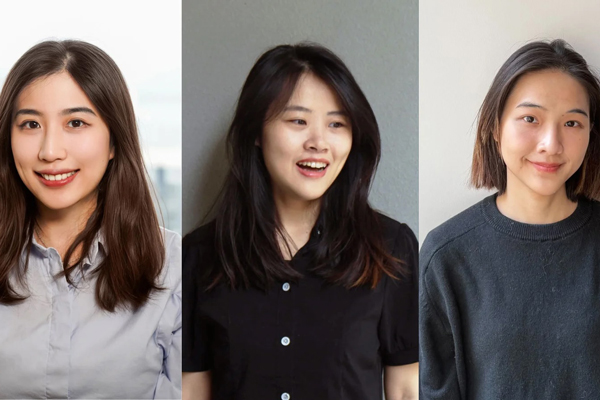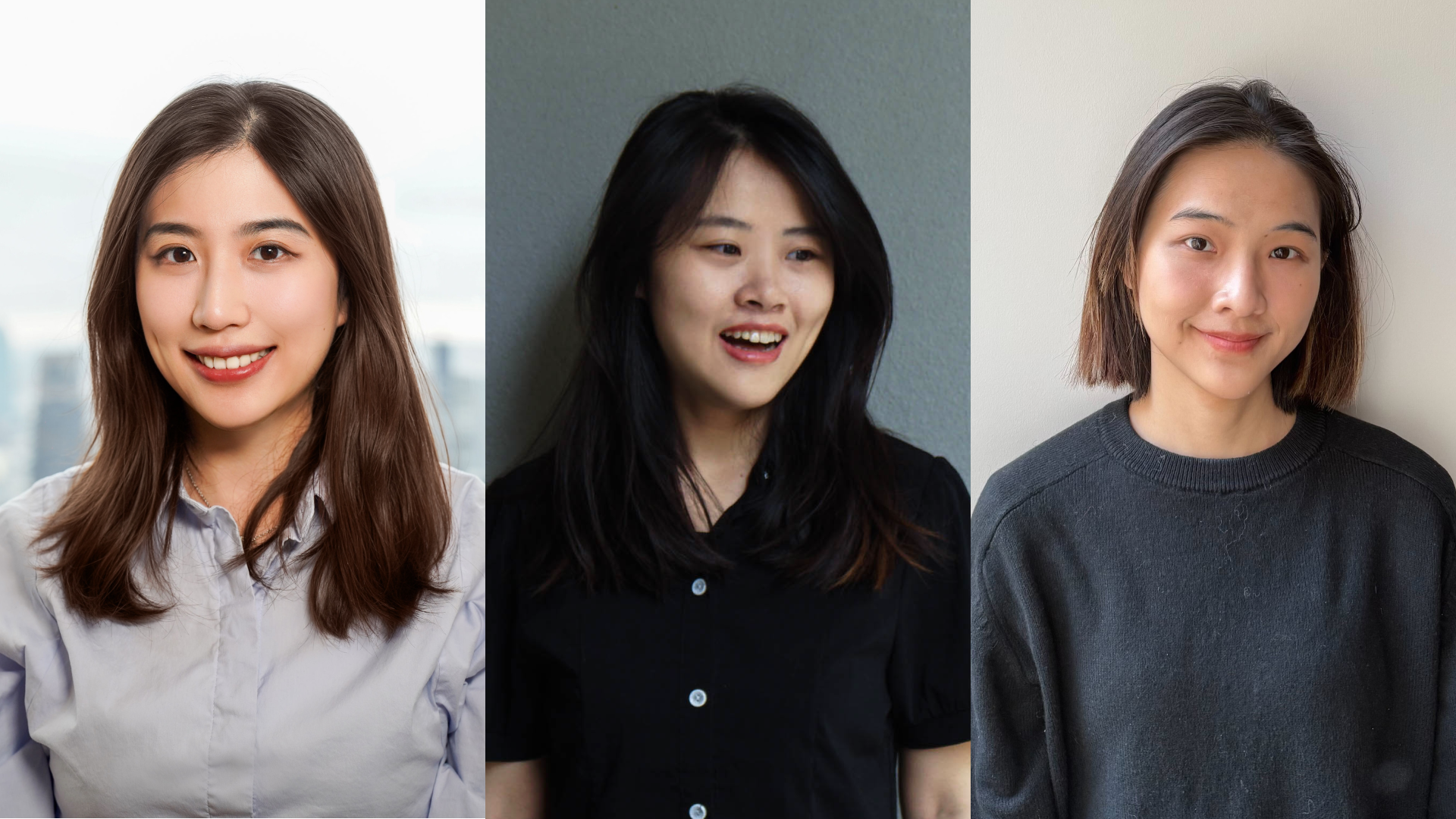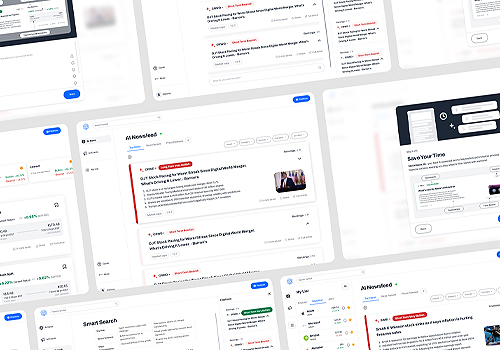
Interview
StockNews AI Team
1 Congratulations on winning the MUSE Design Awards! Can you introduce yourself and share about what inspired you to pursue design as a career?
Yingchia Liu (Serena): My name is Yingchia Liu, but I also go by Serena. As a child, I was always fascinated by aesthetics and drawing, and I dreamed of becoming a designer one day. I pursued a bachelor's degree in landscape architecture but soon realized I was more interested in creating designs that are accessible and useful in people’s daily lives. During this time, I developed a keen interest in integrating technology and design, which led me to transition from landscape architecture to UX/UI and product design. Yenyi Huang: Hi, I’m Yenyi, a designer with a background in architecture and human-computer interaction. I’ve always been drawn to the intersection of space, emotion, and experience—how environments shape behavior and how interfaces can guide understanding. Transitioning from physical spaces to digital ones felt natural to me. I was inspired to pursue design as a career because it allows me to make the complex more intuitive and to craft experiences that connect people meaningfully with technology. ChuYuan Chiu: I’m Chu Yuan, a product designer passionate about UX/UI design, strategy, and content structure. My journey into design started with curiosity about content structure and how information shapes human experiences through technology. I was drawn to the idea of simplifying complexity—taking a problem and turning it into an intuitive, impactful solution. It’s really about making everyday interactions smoother and more meaningful.
2 What does being recognized in the MUSE Design Awards mean to you?
Yingchia Liu: Winning the MUSE Design Awards fills me with immense pride for both my team and myself. This prestigious achievement recognizes our hard work, confirms our skills and creativity, and serves as powerful motivation to continue advancing on my path as a designer. It reinforces my commitment to innovation and excellence, inspiring me to push the boundaries of design even further. Yenyi Huang: It’s incredibly meaningful. This recognition is not just a milestone—it’s a reminder that thoughtful design and deep research matter. It encourages me to keep pushing for work that is both user-centered and strategically impactful. ChuYuan Chiu: I’m truly honored! This recognition validates the hard work, dedication, and strategic thinking that went into our product design. Seeing our work acknowledged on this platform reinforces the value of problem-solving and collaboration in shaping meaningful digital experiences.
3 How has this achievement impacted your career, team, or agency, and what opportunities has it brought so far?
Yingchia Liu: I am still observing and waiting to see what changes will come. Regardless of the specific outcomes, I am confident that it will elevate both my personal and professional life. This recognition provides a platform for more people to appreciate my capabilities as a designer, further establishing my reputation for quality and creativity in the field. Yenyi Huang: Winning this award has sparked meaningful conversations with peers and leaders in the design community. It has helped me gain visibility and credibility as a designer who not only crafts elegant visuals but also drives decision-making through user insights. ChuYuan Chiu: Winning this award has put a spotlight on my work and strengthened my credibility as a designer. It has motivated further conversations with our team to keep pushing the boundaries of UX/UI design on this product.
4 What role does experimentation play in your creative process? Can you share an example?
Yingchia Liu: Experimentation plays a crucial role in my creative process. I believe that great design doesn’t happen in isolation—it evolves through continuous testing, learning, and iteration. Whether conducting quick, low-fidelity tests with real users to validate early concepts or launching a small-scale pilot to gather meaningful analytics data, I view these steps as essential touchpoints in shaping more informed, effective, and user-centered design solutions. This approach not only helps me make data-driven decisions but also fosters innovation by allowing space for discovery and refinement. Yenyi Huang: Experimentation is core to how I work. In this project, I reimagined how financial news could be surfaced using AI. I prototyped several interaction models to test how users interpret layers of information, which led to a redesigned structure that improved comprehension and conversion. I see experimentation as a way to stay open, iterate fast, and refine what truly works. ChuYuan Chiu: Experimentation is a decisive part of my creative process because it’s often how I discover better solutions. For instance, while working on this project, I explored how AI could be integrated into the design to enhance content readability and usability. By experimenting with AI-driven content summarization and event tracking, we aimed to help users quickly grasp key financial insights, ultimately saving them time while delivering greater value. This process involved gathering user feedback, investigating suitable design patterns, and refining the experience to ensure it aligned with user needs.
5 What's the most unusual source of inspiration you've ever drawn from for a project?
Yingchia Liu: I feel that many of my sources are quite common, such as competitive intelligence, other people’s ideas, or their work. Recently, I’ve also drawn inspiration from AI. Perhaps the most unique source is observing people’s conversations and behaviors, which I blend with my own experiences to reflect on how humans think and act. Additionally, I enjoy watching reality shows to observe human interactions during various events. Yenyi Huang: Once, I was inspired by the rhythm of Taiwanese opera—its timing and emotional subtlety—which influenced how I structured a product’s storytelling flow. I love finding inspiration in things that seem unrelated at first but share an emotional or structural logic with the experience I’m designing. ChuYuan Chiu: I once found inspiration in how exhibition spaces are designed to guide visitors through a curated journey. The way museums and galleries use spatial planning and storytelling to lead people seamlessly from one exhibit to another gave me ideas for UI/UX design.
6 What’s one thing you wish more people understood about the design process?
Yingchia Liu: I wish more people understood the UX aspect of the process—if we’re talking about the double diamond, it’s basically the research phases such as Discover and Define. Many outside the industry still don’t realize that these are integral parts of a designer’s role. They often hold the outdated view that designers only focus on visuals, rather than the entire experience and functionality. Yenyi Huang: Design isn’t just about making things look good—it’s about uncovering insights, defining problems, and testing solutions. Good design is not decoration; it’s decision-making. ChuYuan Chiu: Design isn’t just about making things look good. Great design is always backed by research, usability testing, and lots of iteration. At the end of the day, it’s a process of balancing user needs, business goals, technical feasibility, and problem-solving.
7 How do you navigate the balance between meeting client expectations and staying true to your ideas?
Yingchia Liu: There are many aspects embedded in client expectations and reality, but ultimately, we all share the same goal. For me, the most important thing as a designer is to solve the client’s problem while aligning with our business goals. I use this as our North Star to communicate with clients and prioritize what is most important to our objectives and how the idea can achieve that. Yenyi Huang: I believe in co-creation. I try to understand the “why” behind client requests and then bridge that with the user’s needs. When I have strong design conviction, I bring it to the table with data and empathy. It’s not about winning arguments, but about aligning on shared goals. ChuYuan Chiu: I navigate that balance by making sure my ideas align with the client’s goals. I do a lot of research and user testing and use data to back up my concepts, so when I present them, I can show how they meet both the user’s needs and the business objectives.
8 What were the challenges you faced while working on your award-winning design, and how did you overcome them?
Yingchia Liu: One of the biggest challenges was designing a seamless navigation experience that could support multiple layers of content—such as news articles, live events, my personalized watchlist, alerts, and top-performing stocks. Balancing clarity and accessibility across these diverse information types required thoughtful information architecture and intuitive interaction patterns, especially given the fast-paced, data-heavy nature of the platform. Yenyi Huang: One of the biggest challenges was redesigning a product while simultaneously revamping its design system. It required balancing long-term scalability with short-term deliverables. I broke the problem into two design tracks and clarified the scope, so I could focus on user pain points while also maintaining systemic consistency. ChuYuan Chiu: One big challenge was ensuring the design was easy to understand while simplifying complex financial and stock market information. We needed to present data clearly and intuitively so users could quickly grasp insights and recognize the platform’s value. Through thoughtful design—using visual hierarchy, data visualization, and intuitive interactions—we translated complexity into an accessible, user-friendly experience.
9 How do you recharge your creativity when you hit a creative block?
Yingchia Liu: Trying new experiences always pushes me out of my comfort zone and broadens my perspective, which recharges my creativity. I also enjoy viewing other people’s work or visiting exhibitions to draw inspiration. Yenyi Huang: I unplug. I go for long walks, practice yoga, or dance casually—just move my body and give my brain a rest. I’ve found that stepping away and shifting my mindset helps reset my brain and open up new perspectives. Often, clarity comes not from pushing harder, but from allowing space for intuition to return. ChuYuan Chiu: When I hit a creative block, I literally step away from the screen. I go for a run, get a coffee, or visit a museum. Experiencing something different, even outside design, usually helps me return with fresh inspiration.
10 What personal values or experiences do you infuse into your designs?
Yingchia Liu: I place a high value on finding the best deal in my personal life—whether it’s comparing options, weighing pros and cons, or uncovering hidden value. This mindset naturally extends into my approach to design. I enjoy analyzing multiple factors, exploring different possibilities, and striking the right balance between user needs, business goals, and technical feasibility. It’s not just about choosing the cheapest or quickest option; it’s about identifying the smartest, most sustainable solution that delivers the greatest value for everyone involved. Yenyi Huang: Curiosity, empathy, and resilience. I often draw from my multicultural background and personal journey—balancing structure and freedom, clarity and emotion. I believe good design invites people in and leaves space for discovery. ChuYuan Chiu: Clarity and accessibility are at the core of my design approach. I strive to simplify complexity, making interactions intuitive and inclusive so that every user can easily engage with and find value in the product.
11 What is an advice that you would you give to aspiring designers aiming for success?
Yingchia Liu: If you are a UX/UI designer, always advocate for the overall experience, not just a single visual element. This is key to enhancing the user experience. Additionally, aiming for success involves honing your storytelling skills, especially as more tools become available for creating design artifacts. Yenyi Huang: Be curious, ask questions, and learn to tell the story behind your decisions. Tools and trends come and go, but the ability to think critically and design with purpose will always set you apart. ChuYuan Chiu: I’d tell them to stay curious and never stop learning. This field is always evolving, so being adaptable is really important.
12 If you could collaborate with any designer, past or present, who would it be and why?
Yingchia Liu: I would like to collaborate with Don Norman because of his pioneering work in user-centered design and his profound insights into how design can enhance human interaction with technology. Yenyi Huang: I’d love to collaborate with Kenya Hara. His work combines simplicity, philosophy, and deep cultural sensitivity in a way I find incredibly inspiring. I admire how he sees emptiness not as a lack, but as a space full of meaning.
13 What's one question you wish people would ask you about your work, and what's your answer?
Yingchia Liu: I wish people would ask more often about the ideas and explorations that didn’t make it into the final design. Behind every polished product or solution lies an entire journey of experiments, discarded concepts, and thoughtful decision-making that often goes unseen. I’d be delighted to share and walk others through my full iterative process—the trials, pivots, and insights that shaped the outcome. I believe understanding the “why” behind every design choice is just as valuable as seeing the finished product, and it’s in those behind-the-scenes conversations where real learning and creative growth happen. Yenyi Huang: I wish more people would ask, “What do you hope people feel when they use your design?” Because for me, it’s not just about usability—it’s about emotion. I want people to feel clarity, confidence, and sometimes even a quiet sense of joy. ChuYuan Chiu: For this project, I wish more people would ask me, “What excites you most about designing?” My answer would be: what excites me the most is the opportunity to solve real-world problems and make an impact through AI-integrated design. I find it rewarding to take complex challenges and transform large amounts of information into intuitive, accessible solutions that improve how people read and interact with stock news.


